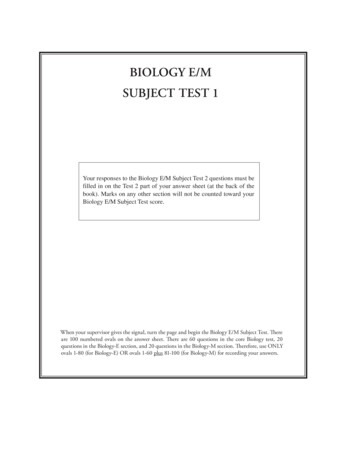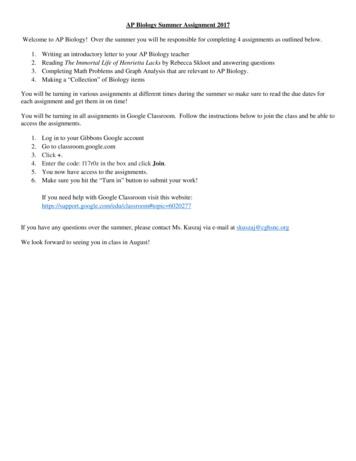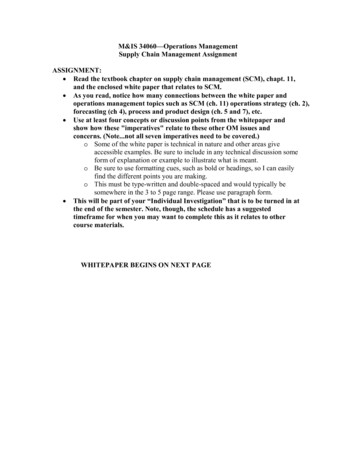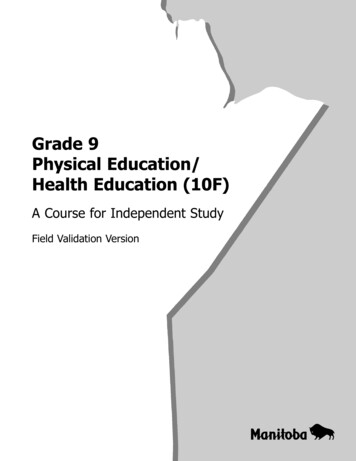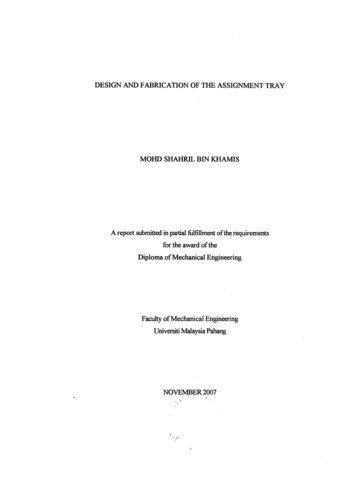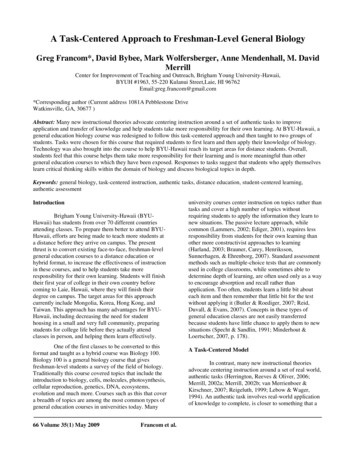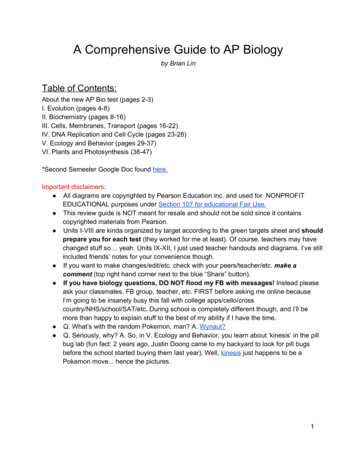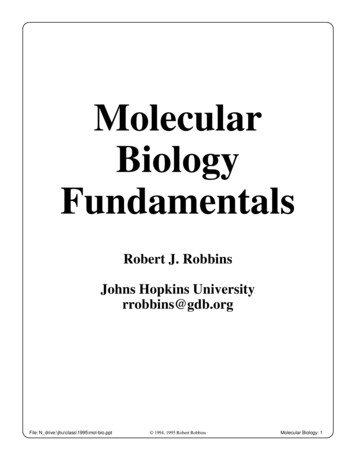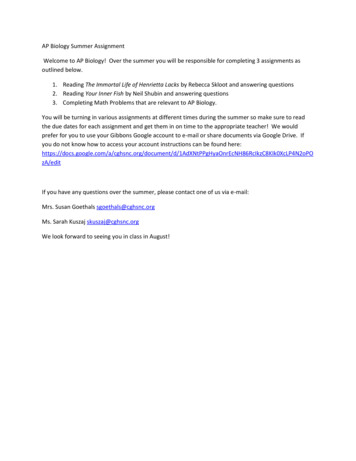
Transcription
AP Biology Summer AssignmentWelcome to AP Biology! Over the summer you will be responsible for completing 3 assignments asoutlined below.1. Reading The Immortal Life of Henrietta Lacks by Rebecca Skloot and answering questions2. Reading Your Inner Fish by Neil Shubin and answering questions3. Completing Math Problems that are relevant to AP Biology.You will be turning in various assignments at different times during the summer so make sure to readthe due dates for each assignment and get them in on time to the appropriate teacher! We wouldprefer for you to use your Gibbons Google account to e-mail or share documents via Google Drive. Ifyou do not know how to access your account instructions can be found itIf you have any questions over the summer, please contact one of us via e-mail:Mrs. Susan Goethals sgoethals@cghsnc.orgMs. Sarah Kuszaj skuszaj@cghsnc.orgWe look forward to seeing you in class in August!
AP Summer Assignment: The Immortal Life of Henrietta LacksDIRECTIONS1. Read The Immortal Life of Henrietta Lacks By Rebecca Skloot and then answer the discussion questions from theRandom House Reading Guide listed below.2. Include your name, course, due date and title on top of assignment as your heading. Prologue, Chapters 1-11 and #s1-8 of Chapters 12-20 due by June 30th via e-mail or shared asGoogle Doc with Ms. Kuszaj skuszaj@cghsnc.org #s 9-18 from Chapters 12-20, Chapters 21-36 and Overall Questions due by July 30th via e-mail orshared as Google Doc with Mrs. Goethals sgoethals@cghsnc.org3. Assignment must be typed (12 pt font) and answers should be clearly labeled & numbered for each chapter.Answer completely and in full sentences. Use good grammar and spelling (AP style) but be clear and concise;discussion should be in your own words even if page numbers are referenced.Prologue: The Woman in the Photograph1. What happens when there is a mistake during the process of mitosis?2. According to Defler, how important was the discovery of HeLa cells?Chapters 1-111. What did Howard Jones find “interesting” about Henrietta’s medical history? What does this findingsuggest about Henrietta’s cancer?2. How are different types of cancer categorized?3. Summarize Dr. TeLinde’s position in the debate over the treatment of cervical cancer.4. Explain how the development of the Pap smear improved the survival rate of women diagnosed withcervical cancer.5. How did TeLinde hope to prove that his hypothesis about cervical cancer was correct?6. Explain what an immortal cell line is.7. Summarize the main obstacles Gey and his assistants faced in their effort to grow cells.8. Where did the name “HeLa” come from?9. What happened to the HeLa cells that Mary cultured?10. What did Gey hope to accomplish with HeLa cells?11. What did HeLa allow scientists to do for the first time?12. How did the media react to Carrel’s announcement that he had grown immortal chicken heart cells?13. What details suggest that Carrel’s claims about the immortal cell line were not scientifically sound?14. After her initial round of treatment, what did Henrietta’s doctors assume about the effectiveness of theradium therapy?15. Describe the progression of Henrietta’s cancer in the eight months between her diagnosis and her death.Chapters 12-20:1. Explain how a neutralization test is used to determine a vaccine’s efficacy.2. What unusual characteristics of HeLa cells made them ideal for use in the polio vaccine trials?3. Paraphrase the explanation of how a virus reproduces found on page 97. Why did the fact that HeLa cellsare malignant make them particularly useful in the study of viruses?4. Why was the development of methods of freezing cells an important scientific breakthrough?5. Why did scientists want to be able to clone cells for research?6. Explain the contribution that HeLa made to the emerging field of genetics.7. Describe the experiment that Southam developed to test his hypothesis about HeLa.8. What was the result of Southam’s first research study? Based on these results, did his hypothesis appearto be correct?
9.10.11.12.13.14.15.16.17.18.Based on the results of the second study, what two things did Southam believe that injections of HeLacells might be able to do?How did Southam justify his decision to inject HeLa cells into patients without their knowledge orconsent?Summarize the various ways that HeLa was used in the space program.What disturbing discovery did scientists make about the way HeLa responded in orbit?Explain what happens during somatic cell fusion.What scientific discoveries were made possible as a result of fused hybrid cells?How was Gartler able to link the contamination problem to HeLa?What unique abilities did HeLa have that allowed it to contaminate cultures without researchers beingaware that contamination had occurred?Why would HeLa contamination be a problem for researchers?What is “spontaneous transformation”? What did Gartler suggest about spontaneous transformation?Chapters 21-361. What was the purpose of President Nixon’s National Cancer Act?2. Why did advances in genetic research necessitate establishing the legal requirement that doctors orresearchers obtain informed consent documentation prior to taking DNA samples from patients forresearch?3. Describe the lawsuit that set a legal precedent for patenting biological “products” such as cell lines.4. Summarize the pros and cons of giving patients legal ownership of their cells.5. What was the Supreme Court of California’s decision regarding the Moore lawsuit? Summarize thereasoning behind the decision.6. Explain how the human papillomavirus (HPV) causes cervical cancer.7. Are scientists able to definitively explain why HeLa grew so powerfully?8. Describe the contribution that HeLa has made to research on the HIV virus and the AIDS epidemic.9. Explain Van Valen’s theory that HeLa cells are “no longer human.” Was his theory accepted by thescientific community?10. Explain the Hayflick limit.11. Why are HeLa cells able to live beyond the Hayflick limit?12. Summarize Gary’s spiritual explanation for why Henrietta’s cells lived on after her death.Overall Questions:1.2.3.There is often a tension between religious faith and science. Explore the importance of both religious faithand scientific understanding in the lives of the Lacks family. How does religious faith help frame theLackses’ response to, and interpretation of, the scientific information they receive about HeLa? How doesSkloot’s attitude toward the relationship between religious faith and science evolve as a result of herrelationship with the Lacks family?Using the book as a guide, describe the process of scientific inquiry. Examine the often contradictoryforces of altruism and profit as they influenced research related to HeLa. What are the risks and benefitsof allowing profit to guide research? What are the obstacles involved with conducting research purely foraltruistic reasons?Create a time line that begins with the removal of Henrietta’s tissue sample and traces the scientific andmedical breakthroughs that have been made possible as a result of HeLa cells. Explain how HeLa cellswere used in each situation.
AP Biology Summer Assignment: Your Inner FishDIRECTIONS1. Read Your Inner Fish by Neil Shubin and then answer the discussion questions listed below.2. Include your name, course, due date and title on top of assignment as your heading. Due on Friday August 22nd via e-mail or shared as a Google Doc with your AP Biology Teacher3. Assignment must be typed (12 pt font) and answers should be clearly labeled & numbered for each chapter.Answer completely and in full sentences. Use good grammar and spelling (AP style) but be clear and concise;discussion should be in your own words even if page numbers are referenced.DISCUSSION QUESTIONSChapter 1 - Finding Your Inner Fish1. Describe the fossil Tiktaalik. Why does this fossil confirm a major prediction of paleontology?2. Explain why Neil Shubin thinks Tiktaalik says something about our own bodies? (in other words – why the InnerFish title for the book?)Chapter 2 - Getting a Grip1. Describe the “pattern” to the skeleton of the human arm that was discovered by Sir Richard Owen in the mid1800s. Relate this pattern to his idea of exceptional similarities.2. How did Charles Darwin’s theory explain these similarities that were observed by Owen?3. What did further examination of Tiktaalik’s fins reveal about the creature and its’ lifestyle?Chapter 3 - Handy Genes1. Many experiments were conducted during the 1950s and 1960s with chick embryos and they showed that twopatches of tissue essentially controlled the development of the pattern of bones inside limbs. Describe at least oneof these experiments and explain the significance of the findings.2. Describe the hedgehog gene using several animal examples. Be sure to explain its’ function and its’ region ofactivity in the body.Chapter 4 - Teeth Everywhere1. Teeth make great fossils - why are they “as hard as rocks?” What are conodonts?2. Shubin writes that “we would never have scales, feathers, and breasts if we didn’t have teeth in the first place.”(p. 79) Explain what he means by this statement.Chapter 5 - Getting Ahead1. Why are the trigeminal and facial cranial nerves both complicated and strange in the human body?2. What are Hox genes and why are they so important?3. Amphioxus is a small invertebrate yet is an important specimen for study – why? Be sure to includecharacteristics that you share with this critter!Chapter 6 - The Best Laid (Body) Plans1. Early embryonic experiments in the 1800s led to the discovery of three germ layers. List their names and theorgans that form from each.2. What is meant by “ontogeny recapitulates phylogeny?”3. What type of gene is Noggin and what is its function in bodies?4. Sea anemones have radial symmetry while humans have bilateral symmetry but they still have “similar” bodyplans – explain Chapter 7 - Adventures in Bodybuilding1. What is the most common protein found in the human body? Name it and describe it.
2. Explain how cells “stick” to one another; give at least one example.3. How do cells (generally) communicate with one another?4. What are choanoflagellates and why have they been studied by biologists?5. What are some of the reasons that “bodies” might have developed in the first place? Include any environmentalconditions that might have favored their evolution.Chapter 8 - Making Scents1. Briefly explain how we perceive a smell.2. Jawless fish have a very few number of odor genes while mammals have a much larger number. Why does thismake sense and how is it possible?Chapter 9 - Vision1. Humans and Old World monkeys have similar vision – explain the similarity and reasons for it.2. What do eyeless and Pax 6 genes do and where can they be found?Chapter 10 - Ears1. An early anatomist proposed the hypothesis that parts of the ears of mammals are the same thing as parts ofthe jaws of reptiles. Explain any fossil evidence that supports this idea.2. What is the function of the Pax 2 gene?Chapter 11 - The Meaning of It All1. What is Shubin’s biological “law of everything” and why is it so important?2. What is the author trying to show with his “Bozo” example?3. This chapter includes many examples of disease that show how humans are products of a lengthy andconvoluted evolutionary history. Choose one (1) of the problems listed below and briefly explain how ancientancestors’ traits still “haunt” us: Obesity Heart disease Hemorrhoids Sleep apnea Hiccups Hernias Mitochondrial diseases
ap/bio-manual/CB Bio TM APPENDIX A WEB.pdffor math formulasAP Biology-Math ProblemsComplete the math problems below according to the follow schedule: Questions 1-4 and Multiple Choice Questions 1-5 due by June 30th via e-mail or shared as GoogleDoc with Ms. Kuszaj skuszaj@cghsnc.orgQuestions 5-9 and Multiple Choice Questions 6-10 due by July 31st via e-mail or shared as GoogleDoc with Mrs. Goethals sgoethals@cghsnc.orgQuestions 10-13 and Multiple Choice Questions 11-16 due on Friday August 22nd to your APBiology teacher1. Include your name, course, due date and title on top of assignment as your heading.2. Assignment must be typed (12 pt font) and answers should be clearly labeled & numbered.Basics: There are many basic math skills that you must be able to do to work the more complex math problemsin AP Biology.1.Working with decimals, ratios, fractions and percentages2.Convert scientific notation to standard numbers3.Report your answer with the number of significant figures that the question requiresDecimals, Ratios, Fractions and Percentages - Example:In a monohybrid cross, when two heterozygotes are crossed, the phenotypic ratio in the offspring is predicted tobe in a 3:1 ratio; approximately 75% will show the dominant phenotype, and 25% will show the recessivephenotype.Two heterozygotes produce 345 offspring1.How many individuals are expected to have the dominant phenotype?How many individuals are expected to have the recessive phenotype?2.The following data was observed; fill in the missing values.Stage of the Cell CycleNumber of Cells in each stage% of Cells in each ophase4On the AP Biology exam, you will only be allowed to use a four function calculator. You will not be able to enternumbers using scientific notation. You must convert to standard numbers, then simply add or subtract (andmaybe convert to percentages) to get the correct answerEnergy Flow in a Hardwood Forest
What percentage of the biomass in the forest community represented is tied up in the grass layer which has aQuestion Mark?Transmitted Light5.0 X 10 5Solar Radiation2.6 X 10 6Absorbed1.6 X 10 6Grasses ?Energy accumulated in Biomass1.8 X 10 4Reflected Light4.1 X 10 5Energy Lost1.3 X 10 6Tree Layer1.2 X 104Shrub Layer4.4 X 10 33.What percentage of the biomass in the forest community is tied up in the grass layer? Give youranswer to the nearest whole number.
4.How much energy gets transmitted to the tertiary consumers?5.The graph shows the growth in cm of a pea plant over a period of 5weeks. What was the mean growth rate per day between week 1 andweek 3?6. Give your answer to the nearest tenth.
Hardy-Weinberg ProblemsThe Hardy- Weinberg formula is p 27. 2pq q 2 1.0The allele for the hair pattern called “widow’s peak” is dominant over the allele for no “widow’s peak”. Ina population of 100 individuals, 91 show the dominant phenotype.What is the frequency of the dominant allele?What is the frequency of the recessive allele?How many individuals would you expect to be heterozygous for the trait?Chi Squre8. A Cellular Biologist wants to double check that statement that cells spend 90 percent of their time inInterphase as compared to the various stages of Mitosis. She grows some Allium in her laboratory. She thentakes one of the plants, cuts off the root tips, stains the DNA in the cells so as to be able to see the stages ofthe cell cycle. Her hypothesis states “If cells spend 90 percent of their time in Interphase, then she should beable to calculate the relative time existing between Interphase and Mitosis based upon the cells counted inher specimen.” She counted 1000 cells from her preserved specimen under the microscope. Her data areshown below. Calculate the X2 to the nearest hundredth.Stage of the Cell CycleNumber of Cells ObservedNumber of Cells osisObserved(O)872128Expected(E)900100Deviation(O – E)D2(O-E) 2D2 / E(O-E) 2/EChi Square Total
In the Diffusion Lab, agar cubes are used to illustrate the relationship of surface area/volume/diffusion rate. Fill inthe values missing in the tableBlockcm x cmSurfaceVolumeSurface Area:Volume RatioArea cmmlA2x22483:1B3x354272:1C4x496641.5:1You use this data to answer questions like this9.Predict- If you put each of the blocks into a solution, into which block would that solution diffusethroughout the entire block fastest? Slowest? How do you explain the difference?10. Describe the relationship between the surface area: volume ratioA study was conducted on the island of Daphne Major in the Galapagos Islands by Peter and Rosemary Grant. Thisstudy lasted over 20 year s. The study investigated how the type of seeds available to the finches impacted thedepth of their beaks. In years when rain and water were plentiful, the available seeds were smaller and easy tocrack. In years experiencing drought, fewer seeds were produced, and the finches had to eat the larger, leftoverseeds produced from previous years. During years of drought, birds with a greater beak depth had a selectiveadvantage.Use the data above to determine the increase in the mean of the depth of the beak between the wet and dryyears. Give your answer to the nearest hundredth of a millimeter.11.The mark and recapture method of estimating population size is used in the study of animal populationswhere individuals are highly mobile. It is of no value where animals do not move or move very little. The numberof animals caught in each sample must be large enough to be valid.1.In the first capture, each animal that is captured is marked in a distinctive way.
2.The marked animals are released into the natural habitat and left for a period of time.3.A second capture is done. Only a portion of the second capture sample will have marked animals.Number of animals in first sample (all marked) x Total number of animals in 2 nd sampleTotal population Number of marked animals in the second sample (recaptured)12. 30 turtles are captured in 1 km2, they are marked and released back into the wild. Two weeks later 30more turtles are caught. 6 had the marking of the original population. Based on this information, what isthe best estimation of the turtle population in the area?There are 4 genes on a single chromosome: A, B, C and D. They exhibit the following crossing over frequencies: A-B 35%B-C 10%C-D 15%C-A 25%D-B 25%13. Determine the order of the genes on the chromosomeMultiple Choice1. In a Hardy-Weinberg population with two alleles, A and a, that are in equilibrium, the frequency of the allele a is0.7. What is the percentage of the population that is homozygous for this allele?a.3b.9c.30d.49Questions 2-3 In a hypothetical population of 1,000 people, tests of blood-type genes show that 160 have thegenotype AA, 480 have the genotype AB, and 360 have the genotype BB.2.What is the frequency of the A allele?a.0.001b.0.002c.0.100d.0.4003.What percentage of the population has type O blood?a.0b.10c.24d.48Refer to the information below to answer the next questions
You are studying three populations of birds. Population 1 has ten birds, of which one is brown (a recessive trait)and nine are red. Population 2 has 100 birds. In that population, ten of the birds are brown. Population 3 has 30birds, and three of them are brown. Use the following options to answer the questions:A.B.C.D.E.Population 1Population 2Population 3They are all the same.It is impossible to tell from the information given.4. In which population is the frequency of the allele for brown feathers highest?a.Ab.Bc.Cd.D5. In which population would it be least likely that an accident would significantly alter the frequency of the brownallele?a.Ab.Bc.Cd.D6. One liter of a solution of pH 2 has how many more hydrogen ions (H ) than 1 L of a solution of pH 6?a.4 times moreb.400 times morec.4,000 times mored.10,000 times more7.Starting with a fertilized egg (zygote), a series of five cell divisions would produce an early embryo withhow many cells?a.4b.8c.16d.328.How many unique gametes could be produced through independent assortment by an individual with thegenotype AaBbCCDdEE?a.4b.8c.16d.329.When crossing a homozygous recessive with a heterozygote, what is the chance of getting an offspringwith the homozygous recessive phenotype?a.0%b.25%c.50%d.75%
10.Two true-breeding stocks of pea plants are crossed. One parent has red, axial flowers and the other haswhite, terminal flowers; all F1 individuals have red, axial flowers. If 1,000 F2 offspring resulted from thecross, approximately how many of them would you expect to have red, terminal flowers? (Assumeindependent assortment).a.65b.190c.250d.56511.Given the parents AABBCc AabbCc, assume simple dominance and independent assortment. Whatproportion of the progeny will be expected to phenotypically resemble the first parent?a.1/4b.1/8c.3/4d.3/812.Huntington's disease is caused by a dominant allele. If one of your parents has the disease, what is theprobability that you, too, will have the disease?a.1b.3/4c.1/2d.1/413.Cinnabar eyes is a sex-linked recessive characteristic in fruit flies. If a female having cinnabar eyes iscrossed with a wild-type male, what percentage of the F1 males will have cinnabar eyes?a.0%b.25%c.50%d.100%14.Cytosine makes up 38% of the nucleotides in a sample of DNA from an organism. Approximately, whatpercentage of the nucleotides in this sample will be thymine?a.12b.24c.31d.3815.To measure the population density of monarch butterflies occupying a particular park, 100 butterflies arecaptured, marked with a small dot on a wing, and then released. The next day, another 100 butterflies arecaptured, including the recapture of 20 marked butterflies. One would estimate the population to bea.200.b.500.c.1,000.d.10,000.
16.A population of ground squirrels has an annual per capita birth rate of 0.06 and an annual per capitadeath rate of 0.02. Estimate the number of individuals added to (or lost from) a population of 1,000individuals in one year.a.120 individuals addedb.40 individuals addedc.20 individuals addedd.400 individuals added
Read The Immortal Life of Henrietta Lacks By Rebecca Skloot and then answer the discussion questions from the Random House Reading Guide listed below. 2. Include your name, course, due date and title on top of assignment as your heading. Prologue, Chapters 1-11 and #s1-8 o



